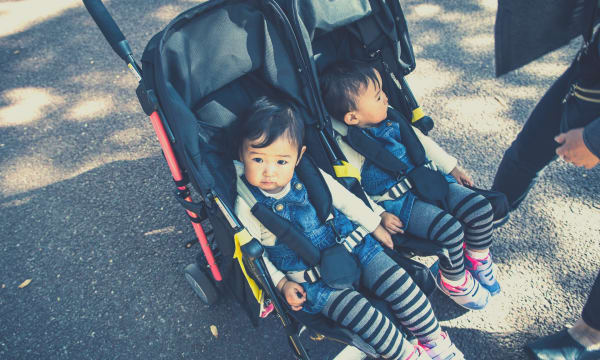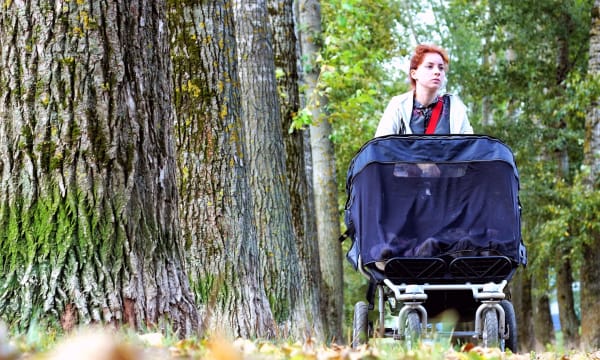Choosing the best double stroller for two children: a side-by-side versus a tandem

TL;DR: A side-by-side stroller means significantly better maneuverability - but a wider chassis. Also, it doesn't offer the benefit of reversible seat unit(s) in most cases. A one-behind-the-other tandem stroller fits better through doorways. It often has at least one reversible seat - but it's longer, and the center of gravity suffers - resulting in considerably worse driving characteristics. In any case, expect the stroller to be bulkier and more expensive.
If expecting twins or already a happy mom-of-one soon to be a happy mom-of-two, you might be looking at double strollers (or single-to-double strollers, for that matter). The choice is a bit more limited to the one of just a single stroller. On the other hand, even in the world of double strollers, there's a wide array of weight classes and different features-packed models, all in different price ranges.

I'll start with my (more) favorite double stroller type, which would be a side-by-side. Essentially, yeah, I am saying a side-by-side is "better" - although it is so because of two reasons I find to be truly important for me: the maneuverability and the children's setup.

The first and most prominent of them would be driveability. To maneuver with a side-by-side is much easier than a tandem (where the older, heavier child is tilting the center of gravity considerably). Especially in the front position, it's making the popping up curbs a nightmare... Or you'll have to take the smaller baby (in the bassinet) nearer you (higher up) - but the older child in the rear - underslung seat with almost no view, as a price to pay for a better center of gravity.
As I already touched on the topic, the next thing to consider would be the position and the resulting children's view. Having both of the kids in the same setup means no arguments about who goes where and the possibilities of communication and bonding of the side-by-side sitting kids. Mostly, the side-by-side type includes strollers with forward-facing seat units, which are maneuverability- and space-wise the best option to last (simpler = more spacious). In such a case, my own favorite would probably be the Baby Jogger City Mini GT2 Double.
The last argument for a side-by-side type would probably be: the most popular, most versatile, and functional double stroller (convertible to a single stroller as well) in the world is the Bugaboo Donkey. It is on the market for a long time and still wanted - even if really expensive - simply because it works best (and there's pretty much no rival). To have a high-quality, compact-enough (for its full size), single stroller convertible to a double, REVERSIBLE seat stroller plus with full-size carrycots (foldable with them, not to forget) is simply worth it.
Sometimes, however, you absolutely DO need a less wide model, and that is when the tandem models have their place. They offer a wide range of configurations, starting with a setup where the older-sibling seat is in the rear lower part. There, you get a considerably shorter stroller chassis, but the kid behind with not much of a view (nor space - look at the Stoke Crusi). Then you have the ones with seat units (or carrycots, when used) at approx. the same level (although those are usually quite long; an example being the ABC Design Zoom or the more buggy-like Joie Evalite Duo). Similar to those, strollers with a "stadium" type of seating situation (the rear seat a bit higher than the from one, so both kids see relatively well - like the iCandy Peach). And don't forget the ones with the front seat being very low to the ground and the rear seat quite high, good for bonding with the smaller child (the high-quality, highly-demanded Uppababy Vista or the ultra-versatile Baby Jogger City Select Lux would be what-to-look-for examples there). The last config is often the case with the single-to-doubles that are already some time on the market - it's a setup with many options for reversing the seats.
Overall, most single-to-double strollers (except the BGB Donkey) are tandems in the two-children (double) configuration. That means that if you already have a little one, and another one will come to join it soon, you'll probably be looking for a convertible stroller usable for one as well as two kids. It does come in handy when you go somewhere with just one child - but also for the time the older won't want to be in the stroller anymore, and you'll only push one in your pushchair.
As I already (honestly) said, from the maneuverability (which is one of my most important criteria) side, the side-by-sides are simply better off. You can't go wrong with a Donkey - not only quality- or functionality-wise, but also because you will most certainly sell it later (and rather quickly). And you can even buy it pre-owned, for that matter. There are other options, and also those for running or for bad terrain will most certainly be side-by-sides, so don't even think of anything else in these cases. Of course, as a full-size stroller, it can't be the most compact - no double stroller will be. Count on a higher weight, less space for a child, and a bulky(ish) stroller, when it's for two babies (that's true for any brand with a double model).
If the most compactness you can get and/or the most space for the child = longevity are on your mind, go for a forward-facing only pushchair with a possibility of carrycot/car seat adapters.
On the other hand, if the width is just putting you off (having a narrow door or often shopping in tight spaces), OR you are getting a two-seats configuration only for a limited time (until the older one doesn't need it anymore)... a tandem pram will be the go-to. With an older/larger kid, it could be practical to think of those models with a bench-like seat available (like a BJ City Select Lux or Quinny Hubb).
